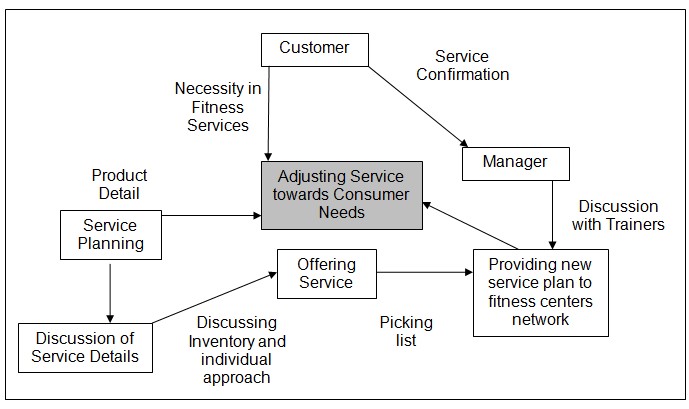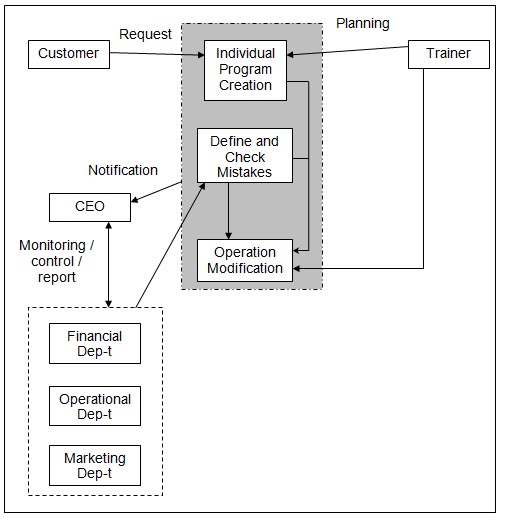
The role of context diagram for understanding the principles of system activity is generally explained by the statement that the diagram gives the visual representation of the company’s structure, and. Independently on the actual difficulties in understanding the key principles of company functioning, the context diagram is generally aimed at providing the required information on the existing links and communication processes between various departments. (Carmichael, 2007) As for the case of Personal Trainer Inc, it should be emphasized that this is one of the few fitness centers that is intended to provide full online support to its consumers. Consequently, it will need the implementation of new systems and principles of business operation. Consequently, the context diagram involves some elements of the decision-making system. (Du-Babcock, 2006)
Anyway, a system can not be understood without a clear representation of the company’s structure. This diagram is built based on the description given in the case study, consequently, it may be relied upon while solving the case study itself. In general, these features will be helpful enough if the company is aimed at restructuring its operational system. (Mack, 2005) Hence, all the weak elements could be removed, or empowered to increase the effectiveness of the system. Additionally, basic principles of communication strategy may be assessed using the offered diagram. (Sapp, 2004)

Communicating system requirements is generally needed for providing the required changes into the system if some are needed. (Verluyten, 2004) Hence, it should be stated that the actual managerial importance of these communication process is explained by the opportunity to provide the timely changes within the frames of the shortest deadline, and with maximum effectiveness. (Waner, 2003)
The required changes may be communicated in several ways simultaneously, however, it does not mean that the effectiveness of these communications will be maximized. (Czerniawska, 2002) However, this will stimulate the quickest mobilization of the resources available and departments that have to be involved into this process. In general, the actual importance of the communication process is explained in New ABA Risk Management Event (2009):
Event management, as a part of the communication process, is considered one of the strategic marketing and communication tools by companies of all sizes. From product launches to press conferences, companies create promotional events to help them communicate with clients and potential clients.
Consequently, the strategic value of communicating the required needs plays an important role in locating the possible structure mistakes after the restructuring process, as well as define the improper resource allocation processes and strategies. (Eckhouse, 2001) In spite of the fact that the new system was implemented with the aim to improve the existing performance, the decisions and solution implementation principles can not be performed with maximal effectiveness, as managers do not have the corresponding deputies in every center in order to perform the reliable control. (Slowinski, Farris, et.al, 2004)
Reference List
Carmichael, K. 2007. Conceptualizing Business Communication. The Journal of Business Communication, 33(3), 327.
Czerniawska, F. 2002. The Use of Language in Business The Use of Language in Business. Basingstoke, England: Macmillan.
Du-Babcock, B. 2006. Business Communication: Past, Present, and Future. The Journal of Business Communication, 43(3), 253.
Eckhouse, B. 2001. Competitive Communication: A Rhetoric for Modern Business. New York: Oxford University Press.
Mack, R. W. 2005. Event Sponsorship: An Exploratory Study of Small Business Objectives, Practices, and Perceptions. Journal of Small Business Management, 37(3), 25.
New ABA Risk Management Event. 2009. ABA Banking Journal, 101(2), 12.
Sapp, D. A. 2004. Global Partnerships in Business Communication. Business Communication Quarterly, 67(3), 267.
Slowinski, G., Farris, G. F., & Jones, D. 2004. Strategic Partnering: Process Instead of Event. Research Technology Management, 36(3), 22.
Verluyten, S. P. 2004. Business Communication and Intercultural Communication in Europe: The State of the Art. Business Communication Quarterly, 60(2), 135.
Waner, K. K. 2003. Business Communication Competencies Needed by Employees as Perceived by Business Faculty and Business Professionals. Business Communication Quarterly, 58(4), 51.